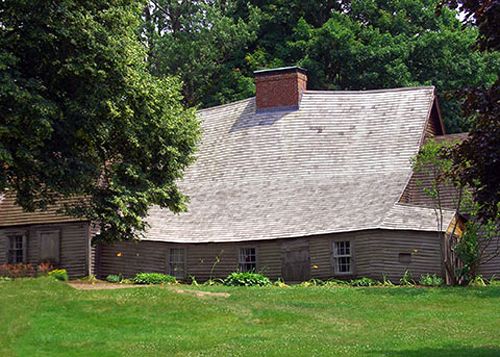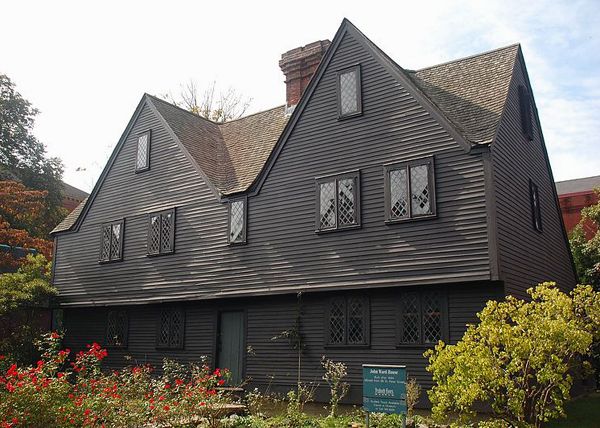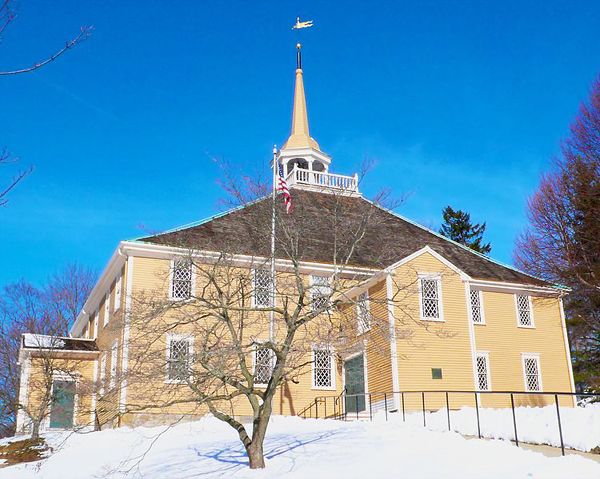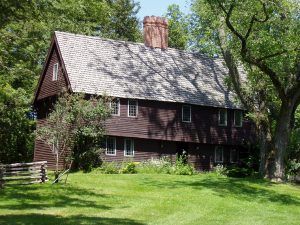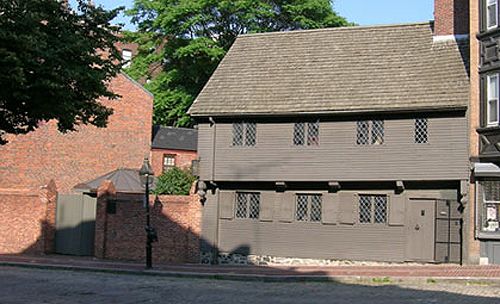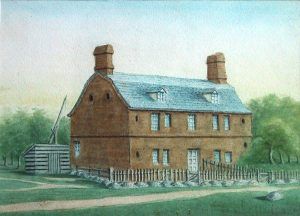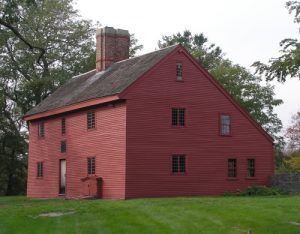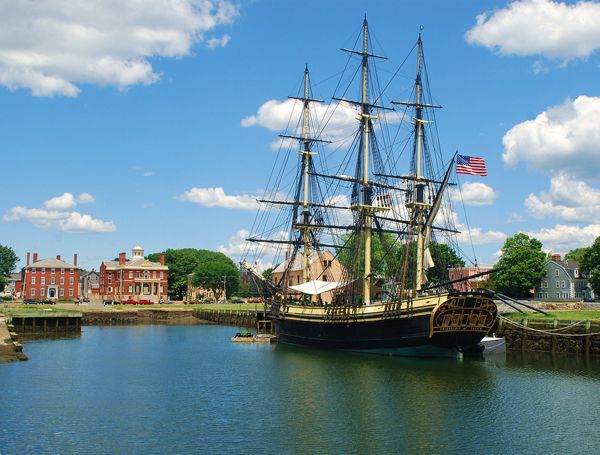Cole’s Hill, Plymouth Rock & the Plymouth Hall Museum, Plymouth
Jethro Coffin House, Nantucket Island
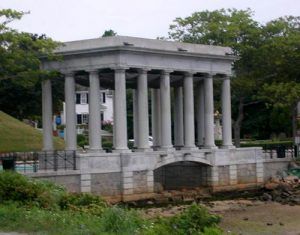
Plymouth Rock Monument
Salem Maritime National Historic Site, Salem
Fairbanks House, Dedham – The Fairbanks House is perhaps the oldest frame house in the United States and is an excellent example of the “growing house” of colonial times. The original portion of the house was built about 1637 or 1638 by Jonathan Fayerbanke, who moved to Dedham from Boston in September 1636. The center portion of the present house is the oldest. As Fayerbanke added to his wealth and land, he added to the size of his home. The original house consisted of a small porch, hall, and parlor downstairs and bed chambers upstairs. A lean-to was later added at the back of the house and, perhaps in 1641, a wing on the east side. Still later, around 1654, the west wing was added. The two wings, which have typical New England gambrel roofs, were undoubtedly completed no later than Fayerbanke’s death in 1668.
From the entry porch in the original portion of the house, stairs lead around the chimney to two second-floor bedrooms. A small porch enters the east wing at the angle where the wing joins the original house. This wing has a parlor and small bedroom on the lower floor and a large second-floor room reached by a winding stairway. The west wing, entered from the hall of the original house, was probably used as sleeping quarters by laborers on the farm. Some authorities believe that the original house was built with oak timbers brought from England — a custom of emigrants that originated in the need to erect houses quickly for defensive purposes.
Today, the Fairbanks House, which has always been owned by the Fairbanks family, is open to the public. It is furnished with family heirlooms. Despite interior alterations occasioned by repairs, plastering, painting, and wallpapering, the antiquity and authenticity of the structure are apparent even to the casual observer. The house is excellently maintained — a labor of love on the part of the Fairbanks descendants, for whom the dwelling is a family shrine. It was named a National Historic Landmark in 1960.
Fairbanks House
511 East Street
Dedham, Massachusetts 02026
781-326-1170
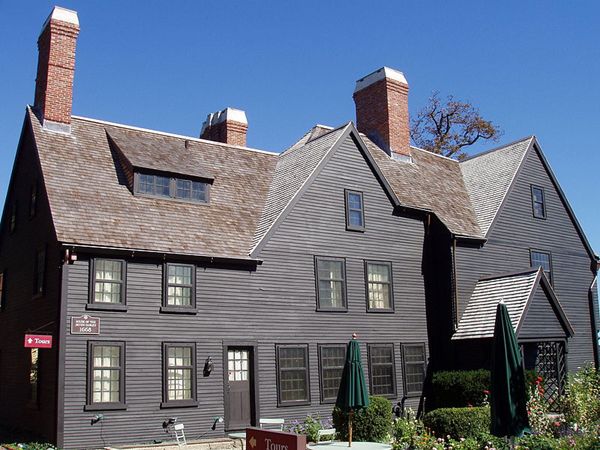
House of the Seven Gables – Salem, Massachusetts. View of the house side, showing the oldest part of the house.
House of Seven Gables, Salem – Long known as the Turner House, the House of Seven Gables is now identified — perhaps inaccurately — with the novel of the same name, published in 1852 by Nathaniel Hawthorne. The earliest section of the weather-beaten, rambling house was built in 1668 by a Salem sea captain and merchant named John Turner. Three generations of the Turner family occupied it before being sold to Captain Samuel Ingersoll in 1782. An active captain during the Great Age of Sail, Ingersoll died at sea, leaving the property to his daughter Susanna, a cousin of famed author Nathaniel Hawthorne. Hawthorne’s visits to his cousin’s home are credited with inspiring the setting and title of his 1851 novel The House of the Seven Gables.
Showing medieval influence, the house has been expanded various times, and the number of gables increased from four to seven. In 1910, it was restored. Numerous pieces of furniture used by various owners are exhibited and items associated with Nathaniel Hawthorne. The House of Seven Gables Settlement Association owns and operates the property.
Over time the organization’s trustees acquired and moved to the site five additional 17th, 18th, and 19th-century structures: The Retire Becket House (1655); The Hooper Hathaway House (1682); Nathaniel Hawthorne’s Birthplace (c1750); The Phippen House (c1782); and The Counting House (c 1830). Today, The House of the Seven Gables campus constitutes its national historic district on The National Register of Historic Places. The property is open to the public throughout the year.
House of Seven Gables
115 Derby Street
Salem, Massachusetts 01970
978-744-0991
Jethro Coffin House, Nantucket Island – One of the few extant 17th-century houses of the long-popular Cape Cod style, the Coffin House was occupied by the Coffin family for over three centuries. Built about 1686, it features a steeply pitched roof, an unusually long rearward slope, and the typical massive central chimney. Small, medieval-type windows indicate the house’s great age. The tall chimney has an exceptionally interesting flue device and an inverted horseshoe, which was supposed to ward off witches.
Maintained by the Nantucket Historical Society, the house provides a fascinating insight into domestic life in rural New England. The structure, which contains the family’s furnishings, began as a simple dwelling built in the post-medieval style. Tristram Coffin and his family lived, cooked, and slept in two or possibly three rooms; their possessions were few. Beginning in 1712, the house doubled in size to provide living space for a married son and his family. As the family grew, they added partitions and lean-tos so that different generations could continue to live together under one roof. In 1785, the two Coffin brothers legally divided the structure into two separate dwellings, each with its kitchen and living spaces. With rooms from the seventeenth, eighteenth, and nineteenth centuries, Coffin House depicts the impact of an expanding economy and new concepts, such as the notion of privacy, on architecture and modes of living.
In 1927, the house was completely restored. It was designated as a National Historic Landmark in 1968. It is located at 16 Sunset Hill in Nantucket, Massachusetts.
Nantucket Historical Association
15 Broad Street
P.O. Box 1016
Nantucket, Massachusetts 02554
508-228-1894
John Ward House, Salem – This clapboard-covered house, built in 1684, reflects the architectural mode of the era. It originally had only one room but was later expanded into a two-story structure distinguished by cross gables and an overhang. Part of the Peabody Essex Museum today, the John Ward house was moved in 1910 from its original site three blocks away. It was restored and furnished to include colonial furnishings. The exposed beams of the kitchen and the fascinating collection of early kitchenware and utensils are of special interest. In 1911 that house opened to the public, becoming the country’s first outdoor architecture museum. The house was designated a National Historic Landmark in 1968. Today the Peabody Essex Museum has grown to include more than twenty pre-Civil War buildings, including four National Historic Landmarks and many properties listed in the National Register of Historic Places. It is located at 132 Essex Street in Salem, Massachusetts.
Peabody Essex Museum
East India Square
161 Essex St
Salem, Massachusetts 01970
978-745-9500 or 866-745-1876
Old Ship Church, Hingham – Some authorities contend that this church, also known as the Meeting House, erected in 1681, is the oldest English church in continuous use in America. The major rival for this distinction is the Newport Parish Church (St. Luke’s) in Smithfield, Virginia. Old Ship Church is undoubtedly the earliest of New England’s churches, and it is a striking survivor of the Puritan settlement of Massachusetts in the 17th century.
The earliest settlement within the bounds of the present town of Hingham dates from 1633. The significant settlement period began in 1635 when a party arrived under the leadership of the Reverend Peter Hobart and soon built the first meetinghouse. According to tradition, the present structure was erected in 1681 by ships’ carpenters. This tradition, plus the “look-out,” or “captain’s walk,” surrounding the belfry, and the curved roof timbers which give the interior the appearance of an inverted ship’s hull, all probably contributed to the church’s name. The church was used for town meetings and village gatherings for more than a century following its construction. In 1791, when the congregation voted to raze it and erect a new church, it narrowly escaped destruction. Fortunately, this move was reconsidered, and the church continued to serve its congregation without interruption.
Today, the simple wooden structure reflects the Puritan rejection of the Gothic architecture of the Anglican tradition. It represents a style of building common to New England meetinghouses of the 17th century, for which no Old World precedent existed. The Puritans also abandoned traditional interior arrangements; the pulpit replaced the altar as the focal point of the service, and benches faced it and ran lengthwise of the church. The main entrance was in the rear of the benches, opposite the pulpit. The church is a unique example of a primitive type of church that has been restored to its original condition. Except for the early 18th-century gallery additions, thanks to careful restoration in 1930, it stands today much as it was initially built. Its Unitarian congregation handsomely maintains it. It was designated as a National Historic Landmark in 1960.
First Parish in Hingham
Unitarian Universalist
90 Main Street
Hingham, Massachusetts 02043
781-749-1679
Parson Capen House, Topsfield – This house, whose setting and interior are superb, is a perfect specimen of a New England colonial residence and of the English manor house in America. Erected in 1682 by Reverend Joseph Capen, minister at Topsfield, Massachusetts, the Parson Capen House is a noteworthy example of a New England colonial dwelling and 17th-century manor house. The skill of workmanship indicates the efforts of craftsmen trained in England. Except for the clapboards in place of half-timbers, the house is a faithful counterpart of the English manor house of the 17th century. The Reverend Joseph Capen, minister at Topsfield for many years, had it built on a 12-acre plot given to him by the town in 1682.
Today, the house framework consists of heavy oak timbers mortised and tenoned and held in place by wooden pins. The foundation timbers rest on an underpinning of unmortared fieldstones. The second story overhangs far out in the front, and the third story projects at each end, the overhangs being supported by wooden brackets. Carved pendants decorate the overhang corners of the building. The staircase which winds up before the chimney in the entry has its original newel post and turned oaken balusters. The exposed brickwork of the chimney in the entry indicates the early construction of the house. The parlor and somewhat smaller hall, or kitchen, constitute the lower floor. The walls are wainscoted in a fashion typical of the period, and the fireplace dominates the hall, more than 8 feet wide, which has rounded back corners and a large flue. The floor has characteristic wide boards, sanded smooth.
The house was acquired by the Topsfield Historical Society in 1913 and restored. The frame timbers are original, but much of the woodwork, inside and out, has been replaced. Furnishings are of the 17th century and include a food hutch, which antiquarians have called unique in America. A baluster-back armchair inscribed “P. Capen 1708” believed to have been part of the wedding furniture of Priscilla Capen, the parson’s daughter. The house is maintained in excellent fashion and is open to visitors during the summer. It was designated as a National Historic Landmark in 1960.
Topsfield Historical Society
1 Howlett Street
Topsfield, Massachusetts
978-887-3998
Paul Revere House, Boston – The Paul Revere House is the colonial home of American patriot Paul Revere during the American Revolution. The house possesses an unusual combination of historical and architectural interests. Although extensively restored, it retains its original framework and is exceptionally significant as downtown Boston’s only surviving 17th-century dwelling and as Revere’s home from 1770 to 1800. John Jeffs probably built the original portion of the house not long after the Boston Fire of 1676, on the site of the Increase Mather parsonage. The house was originally the simple and characteristic one-room type, but by the time Revere moved into it about a century later, it had already been enlarged to three full stories. It was considerably altered during the 19th century when the house was a tenement and used as a store. Increasing regard for the old house led to its rehabilitation, beginning in 1908.
Today, the house’s exterior is 17th-century in character, featuring typical rooflines, overhangs, pendants, windows, and the front door. The kitchen at the rear is an early section of the building. Revere probably used the back door in this kitchen when he set out on his famous ride of April 18, 1775; the front door would not have been safe because North Square was full of British soldiers. In the hall is a recessed fireplace, and a small porch and winding stairs are located in front of the chimney. Summer beams span the ceiling of the large room or hall. The first-floor interior has been restored in 17th-century fashion, but the second-floor chamber is plastered, paneled, and painted as it might have been when occupied by the Reveres. The house is well-maintained and is open to the public. It was designated as a National Historic Landmark in 1961.
Paul Revere House
19 North Square
Boston, Massachusetts 02113
617-523-2338
Peter Tufts House, Medford – A Colonial American house in Medford, Massachusetts, this home is thought to have been built between 1677-1678 and is probably the oldest all-brick house in the United States. The house has been called the “fort” and the “garrison house” because of its thick walls and portholes.
In 1677, Richard Russell of Charlestown sold the land with “one dwelling house and barn” to Peter Tufts, Sr. of Charlestown. The brick mason was William Bucknam, brought over from Chelsea, England, to build homes in 1632. Peter Tufts, Sr. sold the house to his son, Captain Peter Tufts, Jr., in 1680. Despite a remodeling of the house in the 1890s, the exterior and the great oak beams inside make it one of New England’s most interesting colonial dwellings. Maintained by the Society for the Preservation of New England Antiquities, it is open to the public throughout the year on a limited schedule. It was designated as a National Historic Landmark in 1968. The house is located at 350 Riverside Avenue in Medford.
Rebecca Nurse Homestead, Danvers – The Rebecca Nurse Homestead was the home of convicted “witch” Rebecca Towne Nurse, who was hanged during the Salem witchcraft hysteria of 1692. Built in 1678, this is an interesting 17th-century clapboard house whose simple lines and basic workmanship demonstrate colonial building skills. The builder was Francis Nurse, but the house derives its name from his wife, Rebecca. She stoutly maintained her innocence yet could not satisfy her accusers. The house sits on 25+ acres of an original 300 acres occupied by Rebecca Nurse and her family from 1678-1798. The house has been restored and is furnished with period pieces. This is the only home of a person executed during the trials open to the public.
Another unique feature is a reproduction of the 1672 Salem Village Meeting House, where many early hearings surrounding the Salem witchcraft hysteria took place. Also located on the grounds is the Nurse Family Cemetery. It has been a longstanding family tradition that Rebecca’s son and husband retrieved her body after her execution and secretly buried it here. Recently, another victim of the Salem witchcraft hysteria, George Jacobs, was buried here after being found in the middle of the last century on his former property in a lone unmarked grave. This is the only known burial site of anyone convicted of witchcraft during the Salem trials. The house is owned by the Society for the Preservation of New England Antiquities and is open to the public between June 15 and October 15. At other times, it may be visited by appointment.
Rebecca Nurse Homestead
149 Pine Street
Danvers, Massachusetts 01923
Salem Maritime National Historic Site, Salem – Although Salem’s maritime supremacy was of greater significance in later periods of history, particularly during the American Revolution, Salem also has earlier important Maritime history. Until the West was opened and began to yield to the pioneers after the American Revolution, most Americans lived within reach of the sea. Naturally, they turned to it for adventure, a livelihood, and even riches. Indeed, the sea was the first frontier as well as the first highway. From the beginning, the colonists depended upon it to communicate with the homeland and other colonies. Salem and other New England ports figured prominently in the colonial and early republican economy.
Beginning soon in the 17th century, sailing vessels based at Salem plied the world’s sea lanes as they built the commerce upon which Yankee strength came to rest. Founded in 1626 by Roger Conant as the Plantation of Naumkeag and established two years later as the first town in the Massachusetts Bay Colony, Salem owed its prosperity to a seaboard location. From the beginning, her colonists engaged in maritime pursuits; fishing and shipping were soon the leading industries.
As early as 1643, fish, lumber, and provisions were being sent to the West Indies in exchange for sugar and molasses, staples that were brought home and made into rum. Gradually, the orbit of trade was extended to Europe, for the most part to Portugal and Spain, which offered a ready market for dried fish and supplied salt, wine, fruit, iron, and Spanish dollars in return. This trade and that with the West Indies — which, after 1700, developed into the “triangular trade” between New England, the West Indies, and Africa — thrived until 1763 when the long struggle between France and England for the mastery of the American Continent finally came to an end, and the English Government began to enact and enforce measures that stringently limited the commerce of the American colonies. Under these conditions, the economic life of Salem, like that of all ports along the Atlantic seaboard, came to a standstill, and a discontent engendered that grew into resistance and eventually resulted in rebellion.
Designated as a National Historic Site in 1938, Salem Maritime occupies an area of about nine acres bordering Salem Harbor. It preserves a group of structures and wharves that have survived the period of the town’s maritime greatness.
Salem Maritime National Historic Site
160 Derby Street
Salem, Massachusetts 01970
978-740-1650
Compiled by Kathy Alexander/Legends of America, updated January 2023.
Also See:


